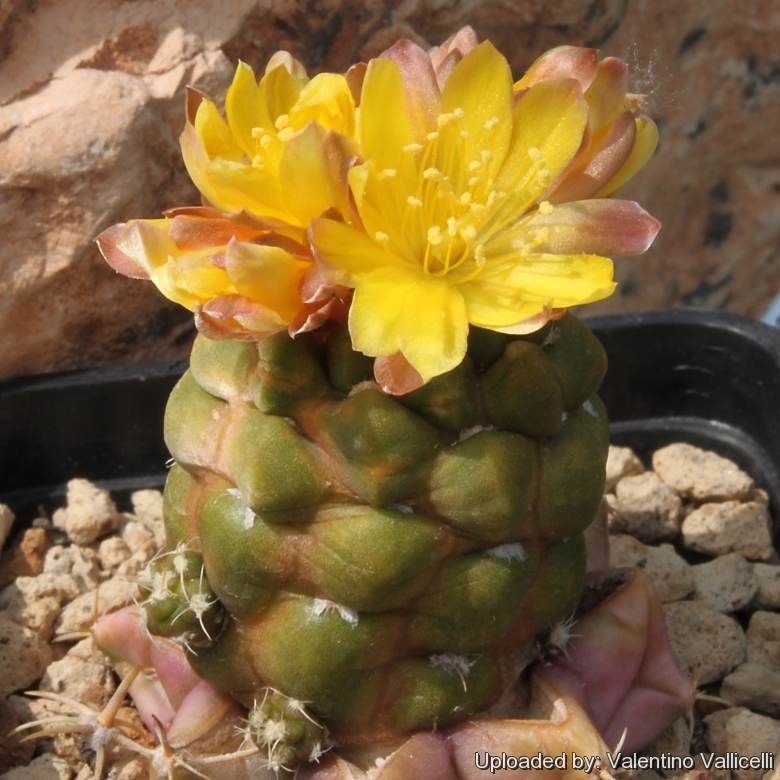




Your support is critical to our success.

Origin and Habitat: Garden origin (Nursery produced cultivar)
Synonyms:
Cintia knizei f. variegata
Accepted name in llifle Database:
Cintia knizei Říha
Kaktusy (Brno) 31(2): 38. 1995 [Apr-Jun 1995]
Synonymy: 3
- Cintia knizei Říha
- Copiapoa knizei (Říha) Halda
- Rebutia cintia Hjertson
Description: The standard Cintia knizeiSN|9806]]SN|9806]] is a solitary dwarf, flat to globose cactus (in the wild), that become cylindrical when it is grafted. The variegated cultivars (Cintia knizeiSN|9806]]SN|9806]] f. variegata) has sectors, patches or stripes with distinct shades of orange.
Stem: Olive-green and orange, up to 5 cm in diameter, globose, covered with large rounded podaria. Apex woolly. The colour can vary depending on the time in the growing season and the amount of sun and water. The base becomes corky with age.
Areoles: The areoles are sunken between the podaria, and are woolly.
Spines: 5-6 short spines only occur on juvenile areoles; adult plants and pericarpel are spineless.
Roots: Deep, tuberous, carrot-like, up to 10 cm long.
Flower: Diurnal, yellow 3-4 cm in diameter on the stem tip, they resemble those of a Copiapoa.
Fruits: Elonged, dry with a thin pericarp, that remain for a long time incorporated within the stem.
Seeds: Black 1,2 mm long 0,7 mm large, the surface is convex and smooth.
Blooming season: Spring.
Remarks: Variegated plants grow slower and are generally smaller than non-variegates of the same species. Coloured areas are also generally weaker, and more susceptible to fungus, sunburn and other defects.
Subspecies, varieties, forms and cultivars of plants belonging to the Cintia knizei group
Notes: Variegation, albinism & schizochromism.
Variegation: A variegated plant has sectors, patches or stripes with two or more different colours, even distinct shades of green. Plants with variegated stems or leaves are often attractive and highly prized. In most species the stems or leaves are normally green, and variegated epidermis is an uncommon mutation, termed a chimera. A chimeral variegation is due to losing the ability to produce chlorophyll in some of the plant’s tissue, so that this tissue is no longer green. Tissues lacking chlorophyll are usually white or pale yellow coloured (due to carotenoid pigments) or red (due to betalain or anthocyanin pigments) contrasting with the normal green tissue. There are several forms of variegation, depending on the tissues that have been affected. The variegation in some forms is unstable. The extent and nature of the variegation can vary, and sometimes the plant will return to the green form. In others it is stable and does not change under normal conditions. Because the variegation is due to the presence of two kinds of plant tissue, propagating the plant must be by a vegetative method of propagation that preserves both types of tissue in relation to each other.
Albinism: Every once in a while a plant exhibits albinism (completely lacking chlorophyll pigment). This means that its tissue is unable to carry out photosynthesis. The result is a completely cream-white plant. This plant will be weaker than a green plant, and albinism is generally a fatal trait (it can't produce its own food and it's not getting it from anything else). Without chlorophyll, the albino plant has no way to manufacture the food needed for survival and growth to maturity. This implies that these plants cannot survive on their own roots and necessitate being grafted on a normal green plant that provides food. Some of these albino plants are indeed very popular, and sought after by collectors.
Schizochromism: The yellow or red appearance of some plants is more precisely caused by another aberration called "schizochromism". Here, though, the specific green pigment (chlorophyll) is missing: every other pigment is present at normal levels. The dominant green colouration is lost, but the plant will still more than likely have normal other pigments that give the yellow overall appearance of stems and the red colouration of spines.
Cultivation and Propagation: Variegated cacti are regarded as choice and difficult in cultivation, but despite that many of them are relatively easy to grow. But be aware that they cannot tolerate prolonged exposure to direct sun light (especially during the hottest summer days), so grow them in half-shade or under filtered sun. They are sometime seen as grafted plants, but some of this colourful plants (those with some chlorophyll) are able to grow on their own roots and are priced by collectors.
Soil: Use mineral well-permeable substratum with little organic matter (peat, humus).
Watering: Water sparingly from March till October, and keep perfectly dry in winter, at temperatures from 5 to 15 degrees centigrade. (In general these plants are more tender and cannot endure freezing temperatures). In the rest period no high atmospheric humidity!!
Propagation: By seeds, grafting or cutting. Because the variegation is due to the presence of two kinds of plant tissue, propagating the plant must be by a vegetative method of propagation that preserves both types of tissue in relation to each other. A most common way way to cultivate this partially de-coloured cultivars is to graft them onto another cactus which has chlorophyll and which will provide sugar to the mutant scion. The chlorophyll containing bottom part of the graft, called the stock, can be any number of different columnar cactus species.
Remarks: Seeds from variegated parents often give raise to some variegated seedlings too.
| Your Actions | |
|---|---|
| Back to Cintia index | |
| Back to Cactaceae index | |
 |
Back to Cacti Encyclopedia index |
Privacy stantement - Terms and conditions - How to cite - About us - Feedback - Donate




